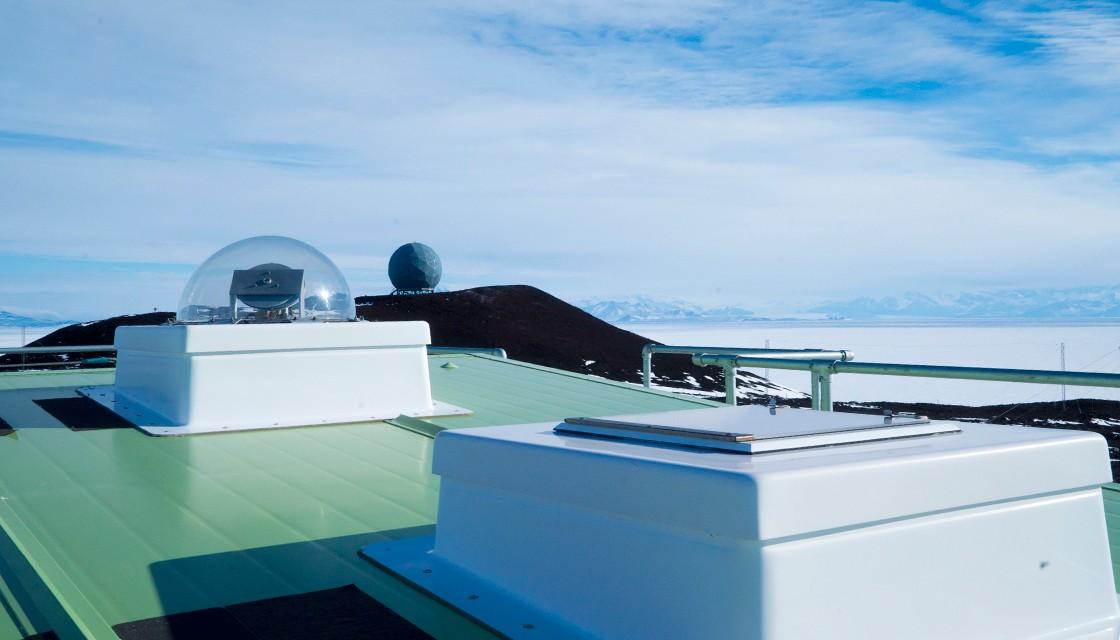Conspiracies thrive in Antarctica. It's locked down tight, they say, patrolled by the military - and only those with official security clearance can enter the most secretive areas.
The Arrival Heights laboratory is inside one of those secure areas. Only those with Government-authorised permits can enter - and, apparently, me.
Rattling up the icy road to the laboratory, the first thing you notice is a strange-looking building off in the distance strongly resembling a giant disco ball. Perched atop a rocky hill, it looks like something out of a sci-fi film.
"We can't show you what's in there," joked one of the personnel I travelled with, pointing at the mysterious orb. I shouldn't have been surprised. She works for the Government.
Crunching over the rocks and snow, I was very aware of what this visit signified. I was taking a glimpse behind the curtains. Nothing was secret from a journalist with a mission.
The lab is in an Antarctic Specially Protected Area (ASPA) - Area 122, to be precise. And after seeing that disco ball, I half expected to find aliens hidden below the ice.
Arrival Heights is blocked off by a series of ropes. Security is low-tech in the most isolated place in the world. A big red stop sign, like you'd see on a normal road, warns anyone without a permit to stay away.
The lab itself is inside a simple container building, a splash of green against the otherwise monochromatic continent. Off in the distance, the orb sits and watches.

Inside the container, it's dim and staticky. Our heavy jackets come off and we're made to sign a book recording our visit. This is it. I'm already further in than most people get to go, and now it's time to head even deeper into this secretive place.
Behind one heavy door is research that's been ongoing for decades, we're told. Stepping inside the room is like stepping back in time.
Area 122 has been home to Kiwi scientists since 1959 and the tech certainly reflects the Antarctic mindset - if it ain't broke, don't fix it. These clunky computers are older than I am, but they work. The interfaces are as basic as they come and instead of a USB port, each computer is equipped with a floppy disk drive. It's not worth the cost of sending down a new computer and taking away the old for disposal, so long as it still works.
Skylights are scattered through the roof, providing a direct access point to the world above. A long, boxy piece of equipment known as the Dobson spectrometer sits in the corner, with a large periscope poking out of it and up through the roof. Its role is to examine the ozone layer, to study that now-shrinking hole above the continent. Other equipment studies the upper atmosphere and auroras - the polar lights.
- Antarctic tourism booming, but at a cost
- The battle against blizzard-like conditions to restore Hillary's historic hut
The equipment down here is so sensitive, visitors are warned about breathing too hard around it, lest you impact research that's been going on for decades. If you're visiting during the endless night of winter, you have to turn off your headlights while driving up the hill so the light doesn't disturb the data readings.
Arrival Heights is a designated 'quiet zone' in an effort to prevent anything, including electromagnetic noise such as the signals coming from your radio, from influencing the raw data.
Finally, an excuse to wear a tinfoil hat.
It's incredible that all of this fragile equipment is housed inside essentially a giant box. Like many Antarctic buildings, the lab is really just a large green container that's been dumped on the ice.
But while the lab itself looks simple from the outside, it's what can be seen across the way that's truly impressive. The orb is massive and almost glitters in the early afternoon sunlight. Stood atop a barren mountain, the orb is what keeps Scott Base connected to the outside world. It houses satellites connecting those living in another set of green containers just over the hill, to the rest of the world.
The orb, mysterious and powerful, really highlights why humans come to this inhospitable place to begin with. Like Scott's Hut, it's a true marker of human endurance - although presented in a totally different way. Research is brought in and sent back. Workers can stay connected with their families. As a news company, we were able to send back live coverage from the ice.
After some manoeuvring to protect the camera, I managed to climb onto the roof of the lab and gaze across the bay. Despite it being early in the summer season, you could still see the frozen sea starting to thin and crack. In just a few months, it will have completely broken up, with open ocean stretching as far as the eye can see.

But turning to face the other direction, there's a surprising sight. Next to a pyramid-shaped mountain sits another mysterious orb. It's smaller and paler, closer to America's McMurdo Station than the one at Arrival Heights.
As we drive away, I can't help but wonder what's within.
Newshub.

